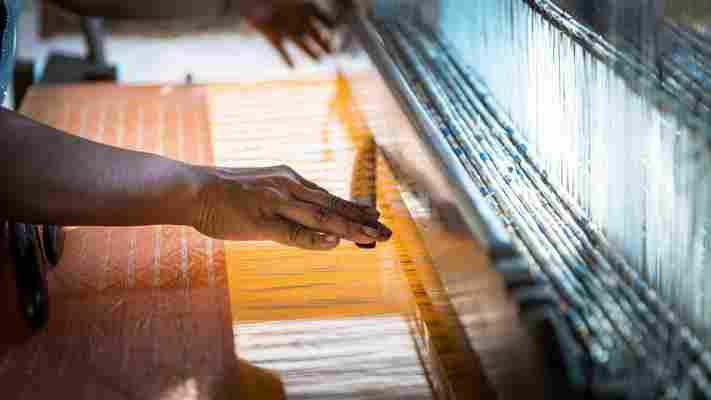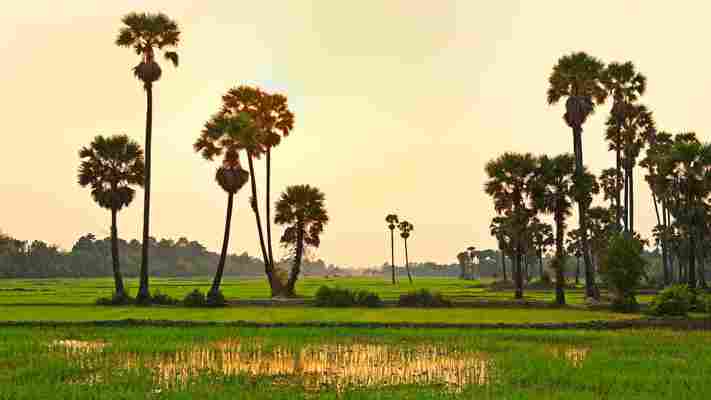Not far from the ancient city of Angkor, a short drive from Siem Reap takes you along Cambodia's old "Silk Road". It weaves through country villages, past lush green rice paddies and into the heart of what was once the centre of the country's sericulture (the cultivation of silkworms to produce silk) and weaving industry.

Ikat weaving – a process that involves creating a pattern by wrapping sections of yarn before it is dyed and woven into fabric – from Cambodia's unique golden silk dates back more than 1,000 years to the Khmer Empire , which flourished from the 9th to 15th Centuries. Silk-making techniques, which created intricate fabrics worn by Cambodian royalty, were passed from mother to daughter. But, like so many traditional crafts and skills, these spinning and weaving traditions were almost lost during the brutal Khmer Rouge regime of the 1970s.
50 Reasons to Love the World - 2021
Why do you love the world?
"Because I was inspired by the infinity of the world and the elegance of mother nature, I was blessed to be born in Cambodia with natural resources and age-old traditions. From fracture damaged by war, I have been able to harness both to try to build a better future for generations to come and create a product which embodies and pays tribute to the beauty and dignity of the Khmer soul." – Sophea Pheach, silk maker
More Reasons to Love the World
Under the regime and the decades of civil war that followed, about a fifth of Cambodians lost their lives and 90% of the country's artists and artisans were killed. The Khmer Rouge targeted intellectuals, artists and musicians who didn't fit into leader Pol Pot's image of a new Cambodia, where history was to be reset to "year zero" and the country was to be freed from what he considered decadent culture. With these artisans died skills and traditions that had been passed from generation to generation for centuries. However, work to re-establish these important aspects of Cambodian culture are now being carried out by inspiring individuals such as silk maker Sophea Pheach.
The daughter of a diplomat, Pheach escaped the harsh realities of the Khmer Rouge era as she lived with her immediate family in Paris. However, as an adult, she went to work in refugee camps for Cambodians in Thailand, returning to Cambodia after the Paris Peace Accords was signed in 1991. Her journey led to her setting up Golden Silk Pheach in 2002, a project that has revived the silk-weaving art and ultimately helped many people whose lives were devastated by the conflict.
Initially, Pheach was asked to help manage an EU-funded project to reinvigorate the country's silk weaving industry. However, the silk being used was mostly imported white silk, and Pheach wanted to reintroduce the golden silk traditionally used in Cambodia.
"We lost all our relatives during the war, all the people who linked us to our country, and I didn't want to lose the thing I had lost deep in myself to be lost again in the story of Cambodia," Pheach told me as we sat in the shade outside her silk showroom in Siem Reap. "We have a particular biodiversity here that supports this very rare and precious golden silk and a tradition of weaving that spans centuries. When I came back, I wanted to protect this biodiversity and to keep this unique tradition alive."

The drive from Siem Reap to Cambodia's centre of sericulture weaves through country villages, past rice paddies (Credit: John W Banagan/Getty Images)
Cambodia's golden silk is spun from the cocoons of golden silkworms, rather than the white ones found elsewhere in the world, which have adapted to the warm tropical climate of northern Cambodia and feed on a native variety of mulberry. The area around the Angkor complex is also a source of fruit such as chambak, which provides a deep, nearly black dye, and the prohut tree, the bark of which yields a natural yellow colour, as well as other sources of natural dyes used to create ikat silk.
I visited Golden Silk Pheach in October 2019 before the Covid lockdown. Just outside the showroom was a large 3D photograph of a 12th Century sculpture of a woman, the famous queen Indra Devi of Jayavarman 7th, from the temple at Angkor Thom. Pheach handed me a pair of 3D glasses, which brought the carved fabrics draped around this ancient queen into sharp relief.
"This is how I began researching the sophisticated weaving techniques that existed during the golden age of Angkor," Pheach explained. "I examined everything I could find, from the temple carvings to samples of fabrics from the 17th Century in the National Museum of Cambodia in Phnom Penh. It took more than 10 years and a lot of trial and error to work out these forgotten techniques of silk weaving."
Cambodia's golden silk-making industry had been virtually wiped out by the Khmer Rouge (Credit: Golden Silk Pheach)
"The Cambodians are well known for their complex ikat patterns," said Southeast Asian textiles expert, Jenny Spancake. "But the fact that textiles do not survive well means we have to make a lot of guesses about their history and specific techniques. The bas-reliefs at Angkor Wat illustrate the wide variety of uses of sumptuous textiles within the Khmer court, including clothing, pillows, curtains and banners, and by the 19th Century, the Cambodians produced an intricate and distinctive weft ikat [where the cross threads on a loom are dyed and the pattern is formed as part of the weaving process]."
But before Pheach could begin to revive the textile weaving process, she needed the raw materials; but these too had been virtually wiped out by the Khmer Rouge.
The success of the original Angkor Empire was based on its ability to grow more rice than was needed, which freed up labour to build temples and fight the wars that expanded the kingdom and thus its wealth. Almost five centuries on, the Khmer Rouge attempted to do the same, but in the process of planting rice, they destroyed acres of the mulberry trees that the silkworms feed on. At the end of their reign of terror in 1979, there were just 47 acres of mulberry trees left in the country.
At Golden Silk Pheach, workers unravel silk from the cocoons and later spin it onto bobbins (Credit: Golden Silk Pheach)
"We planted 29 acres of native mulberry trees on this site, and everything is grown without chemicals, pesticides or insecticide that would harm the fragile silkworms," Pheach said, as she led me around the plantation, which surrounds the breeding sheds. "Golden silkworms are a gourmet breed and need fresh mulberry leaves for their daily meals."
Golden silkworms produce less silk than the more common white variety – 300 to 400 momme (a silk thread measure) per cocoon versus 1,400 momme per cocoon – but they are easier to cultivate in Cambodia's tropical north than elsewhere in the world. Golden silkworms have a 42 day life cycle during which they deepen in colour and spin their golden cocoon from which silk is extracted.
In an airy single-storey building at the plantation, three elegantly dressed Cambodian women sat on wooden stools unravelling the silk from the cocoons. They carefully hooked the first thread of silk from a cocoon before teasing it out by spinning the outer raw silk and then the finer inner silk. Once enough had been extracted, the resulting vibrant golden silk was sorted, washed and spun onto bobbins.
Cambodia's golden silk is spun from the cocoons of golden silkworms (Credit: Golden Silk Pheach)
This golden thread that I watched being produced runs right through the history of Cambodia – and Pheach's work will help ensure that it will also be woven into the country's future. Her aim is twofold: to re-establish a tradition that goes back hundreds of years, and to rebuild the silk industry for generations to come.
"The Cambodian people are very spiritual and believe the spirits of ancestors need to be respected and honoured," said Professor George Chigas, who teaches Cambodian Studies at the University of Massachusetts Lowell in the US. "So, honouring and preserving the teachings of those who died during the Khmer Rouge is a way of restoring and preserving the soul of the nation."
In the weaving area of the farm, the spun silk was arranged on a large wooden frame, and the painstaking process of transferring patterns, which had been drawn onto graph paper, began.
Making Ikat or brocade it a labour-intensive process that can take up to three years (Credit: Golden Silk Pheach)
"It can take up to three years to make one piece of Ikat or brocade," Pheach explained as we watched women wrapping sections of thread with ties that replicated the pattern on the paper. These ties are removed once the silk has been dyed, and when it is woven, the colours, miraculously, fall into place. It's a feat of determined accuracy and precision, and like everything at Golden Silk, it can only be done by hand. The labour-intensive process is reflected in the price of the final products, which are all commissioned as single pieces: from $3,000 (about £2,100) for a shawl to $50,000 (about £35,000) for a large wall hanging.
I wanted to create products that give Cambodian silk international renown
"I wanted to create products that give Cambodian silk international renown," said Pheach.
But the final product is only half the story.
Golden Silk is not just about silk production and weaving, it's about creating jobs for people whose lives and livelihoods were destroyed by war. More than 100 employees work on the plantation; most of them are women, many of whom were orphans who had no homes, no family and no means of survival. Now they have skilled work and status in society, and they call the woman who gave this to them "Mummy".
Golden Silk Pheach has provided jobs to more than 100 employees, most of whom are women (Credit: Golden Silk Pheach)
We often talk about the "fabric of society" as a metaphor for social order, but within this is the idea that society is made up of many different threads. At Golden Silk, Pheach has made this metaphor literal: she is helping to recreate a society destroyed by war at the same time as creating a new generation of traditional fabrics and fabric makers.
"When you bring together the warp and weft on the loom, you mix the threads together to create a bigger picture, and I hope that this is what we are doing here," she said.
BBC Travel celebrates 50 Reasons to Love the World in 2021, through the inspiration of well-known voices as well as unsung heroes in local communities around the globe.
---
Join more than three million BBC Travel fans by liking us on Facebook , or follow us on Twitter and Instagram .
If you liked this story, sign up for the weekly bbc.com features newsletter called "The Essential List". A handpicked selection of stories from BBC Future, Culture, Worklife and Travel, delivered to your inbox every Friday.
